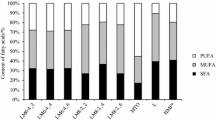Abstract
Milk fat fractions from supercritical carbon dioxide (SC-CO2) extraction were compared with commercial melt crystallization (MC) fractions for their physical and chemical properties. The fractions were analyzed for fatty acids, triacylglycerols, cholesterol, total carotenoid content, and volatile compounds. The fractions were also evaluated for solid fat content (SFC) by pulsed nuclear magnetic resonance and thermal profiles by differential scanning calorimeter (DSC). The distribution of fatty acids and triacylglycerols in the fractions depended on the fractionation technique used. SC-CO2 separated fractions based on molecular weight rather than on melting point, which is the driving force for the MC process. The differences among the fractions were quantified from their SFC and DSC curves. Triacylglycerol profiles by high-performance liquid chromatography showed that the SC-CO2 fractions were distinctly different from each other and from MC fractions. The SC-CO2 solid fraction (super stearin) was the most unique. It had a high concentration of long-chain, unsaturated fatty acid-containing triacylglycerols in a narrow range of high molecular weight, indicating a homogeneity of this fraction that has not been attainable by other techniques. It was also enriched in β-carotene and was devoid of volatile compounds. As compared to liquid MC fractions, the liquid SC-CO2 fraction had a high concentration of low-melting triacylglycerols and was enriched in volatile compounds. With SC-CO2, it is thus possible to simultaneously fractionate and produce a flavor-rich concentrate at no extra processing cost.
Similar content being viewed by others
References
Kaylegian, K.E., and R.C. Lindsay, Handbook of Milk Fat Fractionation Technology and Applications, AOCS Press, Champaign, 1995.
deMan, J.M., Modification of Milk Fat by Removal of a High-Melting Triglyceride Fraction, Can. Inst. Food Technol. J. 1:90–93 (1968).
Fjaervoll, A., Anhydrous Milk Fat Fractionation, Dairy Ind. 35:502–505 (1970).
Norris, R., I.K. Gray, and A.K. McDowell, The Chemical Composition and Physical Properties of Fractions of Milk Fat Obtained by a Commercial Fractionation Process, J. Dairy Res. 38:179–191 (1971).
Larsen, N.E., and E.G. Samuelsson, Some Technological Aspects on Fractionation of Milk Fat, Milschwissenschaft 34:663–665 (1979).
Arul, J., A. Bourdeau, J. Makhlouf, R. Tardif, and M.R. Sahasrabudhe, Fractionation of Anhydrous Milk Fat by Supercritical Carbon Dioxide, J. Food Sci. 52:1231–1236 (1987).
Shishikura, A., K. Fujimoto, T. Kanedo, K. Arai, and S. Saito, Modification of Butter Oil by Extraction with Supercritical CO2, Agric. Biol. Chem. 50:1209–1215 (1986).
Rizvi, S.S.H., Supercritical Fluid Processing of Milk Fat, Newsletter of the Northeast Dairy Foods Research Center 3(11):1–5 (1991).
Bhaskar, A.R., S.S.H. Rizvi, and J.W. Sherbon, Anhydrous Milk Fat Fractionation Using a Continuous Countercurrent Pilot-Scale Supercritical Carbon Dioxide System, J. Food Sci. 58:748–752 (1993).
Dieffenbacher, A., P.-A. Golay, and L.B. Fay, Einige Bemerkungen zur Anwendung der offiziellen Methoden des # 35 des Deutschen Lebensmittelgesetzes zur Bestimmung des Cholesteringehaltes in Eiersatzprodukten, Dtsch. Lebensm. Rundsch. 90:74–77 (1994).
British Standards Institute, London, British Standards Institute Method BS 684: section 2.20 (1977).
Nickerson, G.B., and S.T. Likens, J. Chromatogr. (21):1–5 (1966).
Gresti, J., M. Bugaut, C. Maniongui, and J. Bezard, Composition of Molecular Species of Triacylglycerols in Bovine Milk Fat, J. Dairy Sci. 76:1850–1869 (1993).
McCarthy, M.J., A. Kuksis, and J.M.R. Beveridge, Gas-Liquid Chromatographic Analysis of the Triglyceride Composition of Molecular Distillates of Butter Oil, Can. J. Biochem. Physiol. 40:1693–1703 (1962).
Arul, J., A. Bourdeau, J. Makhlouf, R. Tardif, and T. Bellavia, Fractionation of Anhydrous Milk Fat by Short-Path Distillation, J. Am. Oil Chem. Soc. 65:1642–1646 (1988).
Deffense, E., Multi-Step Butteroil Fractionation and Spreadable Butter, Fett Wiss. Technol. 89:502 (1987).
Banks, W., Chemical and Physical Properties of Milk Fat, in Utilization of Milk Fat, Bull. No. 260, Int. Dairy Fed., 1991, p. 4.
Belousov, A.P., and V.M. Vergelesov, Polymorphism in Butterfat, in Proceedings 16th International Dairy Congress, Copenhagen, Sec.III:1, p.122 (1962).
Deffense, E., Fractionated Milk Fat Products in Bakery Products, in Proceedings New Uses for Milk Fat, Dairy Sciences Research Center, Laval University, Quebec, 1989, p. 79.
deMan, J.M., Polymorphism in Milk Fat, Dairy Sci. Abst. 25:219 (1963).
Foley, J., and J.P. Brady, Temperature-Induced Effects on Crystallization Behavior, Solid Fat Content and Firmness Values of Milk Fat, J. Dairy Res. 51:579 (1984).
Mortensen, B.K., Physical Properties and Modification of Milk Fat, in Developments in Dairy Chemistry 2: Lipids, edited by P. Fox, Applied Science Publishers, 1983, p.159.
Mulder, H., and P. Walstra, The Milk Fat Globule Emulsion Science as Applied to Milk Products and Comparable Foods, Commonwealth Agriculture Bureaux, Farnham Royal, Bucks., England, and Center for Agriculture Publishing and Documentation, Wageningen, The Netherlands, 1974.
deMan, J.M., Physical Properties of Milk Fat, J. Dairy Res. 28:81–86 (1961).
Sherbon, J.W., and R.M. Dolby, Preparation and Fractionation of the High Melting Glyceride Fractions of Milk Fat, Ibid.:52 (1973).
Keogh, M.K., and A.C. Higgins, Anhydrous Milk Fat 3. Fraction Aspects, Irish J. Food Sci. Technol. 10:35 (1986).
Black, R.G., Pilot-Scale Studies of Milk Fat Fractionation, J. Dairy Technol. 28:116 (1973).
Antila, V., The Fractionation of Milk Fat, Milk Ind. 81:7 (1979).
Singh, B., and S.S.H. Rizvi, Design and Economic Analysis for Continuous Countercurrent Processing of Milk Fat with SC-CO2, J. Dairy Sci. 77(6):1731–1745 (1994).
Author information
Authors and Affiliations
Corresponding author
About this article
Cite this article
Bhaskar, A.R., Rizvi, S.S.H., Bertoli, C. et al. A comparison of physical and chemical properties of milk fat fractions obtained by two processing technologies. J Amer Oil Chem Soc 75, 1249–1264 (1998). https://doi.org/10.1007/s11746-998-0170-0
Received:
Accepted:
Issue Date:
DOI: https://doi.org/10.1007/s11746-998-0170-0




